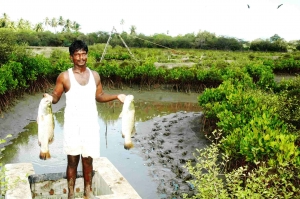Natural Shrimp Farms
3rd Apr 2013
Mangrove ecosystems are well known for their multiple benefits; they provide buffers from storms, a critical nursery habitat for many species of commercial fish, and are recognized as one of the most effective carbon sinks. Yet since 1980, a fifth of mangroves around the world have been lost through conversion to shrimp farming, aquaculture, and urban and industrial use. The reason for the continued degradation of the mangrove ecosystems is that often their true value is not recognized. Instead they are still viewed by planners as low value spaces to be cleared and transformed into commercially viable areas. Continued loss of mangroves will have lasting ecological and socio-economic impacts on coastal communities.
In many places land that was converted for shrimp farms now lies degraded and unproductive. One solution may be to reintroduce mangroves in a new kind of poly culture farming system.
A MFF project recognized the pressing need to return these lands to productivity, and designed a brackish water and mangrove-based farming system for wider replication. The farms work on the principles of ecological sustainability. They are fed by tidal water, making pumps unnecessary. The tide brings in natural fish and shrimp, and flushes away wastes. The model has a very high mangrove survival rate (92%). Also encouraging were survival rates for introduced tiger prawn and mullet and sea bass fingerlings (60%). Over 120 community members and government staff were trained in the system, which proved extremely popular. The M.S. Swaminathan Research Foundation is performing long-term monitoring to ensure the system is sustainable. The Aquaculture Authority of India is exploring the possibility of eco-labeling products from these environmentally friendly farming systems, providing vital market links needed to support replication of the system.

